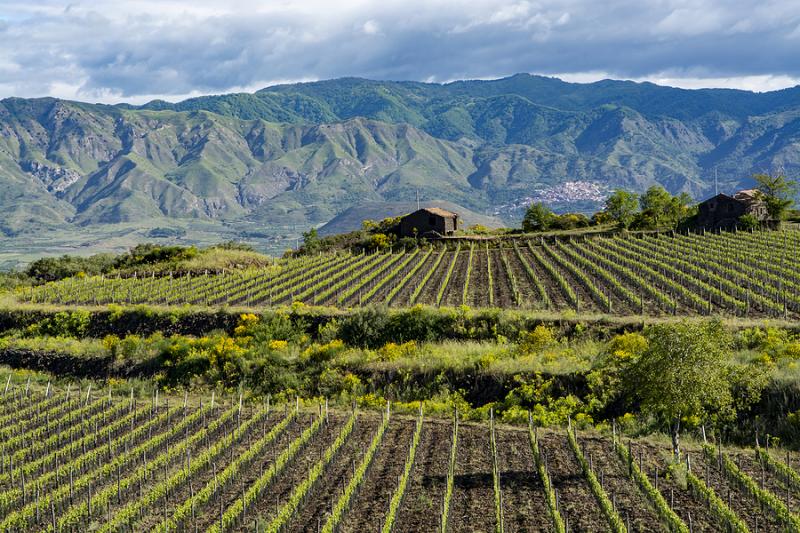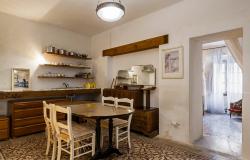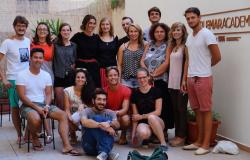In his book, the New Wines of Mount Etna journalist and professional winemaker Benjamin Spencer explores the Mount Etna wine-producing area in a mixture of culinary history and guide book.
Spencer’s takes us from the plant through to the bottle in a series of fascinating observations on the nature of viticulture. He suggests how archaeological evidence shows how humans have been making wine in Sicily for 6,000 years, so what better place is there to explore the art of winemaking.
The vines on Etna have been found to have survived decades after lava eruptions from the very active Sicilian volcano, with an astounding tenacity. It seems a privilege to explore this beverage made from the fruit of a plant that refuses to give up.

Spencer walks us through various stepping stones in the history of Sicilian wines revealing subtle elements of this region of Italy’s complex history. From the origins of Mt Etna’s first modern vineyards which were planted near the sea in the lower Alcantara valley at Capo Schizo’ around 730 B.C.
The geographical layout of the volcanic soil makes winemaking in this area to be exclusively manual labour. It is rugged terrain to cultivate, and so these difficulties make it a labour of love. There is no chance of mechanical ploughing; harvesting is done by hand. The volcano’s climate creates many challenges from severe winds, the lack or excessive level of rainfall, and changeable environmental factors. So the winemakers of Etna are very much motivated by their unique connections to the area and particular dedication to winemaking. Etna seems to call people to it with a mixture of magic and fascinating beauty.
Like this article? Then you don't want to miss "A Guide to Exploring Sicilian Wines"
In the New wines of Mount Etna, we get a sense of the real ebb and flow of the wine industry in Sicilies history. From the damage created by the importation of the phylloxera bacteria which killed off many indigenous varieties. To the general decline in the Sicilian wines of past centuries because of low quality, techniques and bad administration.
There have been several historical upheavals in Sicilian history which have had a significant impact on the wine industry. Such as the decision of Muslim governors of the island in the middle ages who began uprooting vines. It was thanks to the practitioners of Christianity and Judaism who were able to protect some pockets of native vineyards. To more recent times in 1986 when a Methonal poisoning scandal threatened to end the industry entirely.
Spencer tells us of the Angevin (French) period in 1268 when Italian bureaucracy became gradually worse up until the Aragonese (Spanish) period of 1282, creating a web of confusion and deception which lead to a period of stagnation. Then the Franciscan monasteries hosting travelling pilgrims crisscrossing the island communicated in the culture of wine kept Sicilian wines alive for many centuries after.
The influence of the English also played a hand in keeping Sicilian wines alive. The Maniace Abbey in Catania province became the seat of the Camera Regionale a critical feudal state during the period of the kingdom of two Sicilies. Admiral Horatio Nelson was given the title of the Duca di Bronte, after saving the life of the Spanish Monarch from the invading French army of Napoleon. The 22,000 acres property near Maniace outside of Randazzo included the Benedictine Abbey of Maniace was a significant producer and exporter of local Sicilian wines to Spain and Britain.
English men like John Woodhouse and Benjamin Ingham invested heavily in the Marsala winemaking industry at Mazara del Vallo in western Sicily. Their wines became immensely popular in 1800 Britain. Woodhouse eventually supplied the British Royal Navy with Marsala wine, thanks to the connection with Lord Horatio Nelson in Sicily.
Benjamin Spencer suggests that by the beginning of the twenty-first century, all the modern tools and intentions were in place for a Renaissance on the mountain. Spencer sustains that this unique wine region is in the midst of an exciting revival of Sicilian wine.
Spencer shares his personal stories and interactions with the wine producers of Etna, which gives us a sense of how it is to visit and work on Mount Etna. There is an unpretentious, hands-on nature to the wine industry here. Spencer says how things are done differently on Mt Etna. No one serves you crackers and expects you to be happy about it. On Etna, you’re a guest. No doubt, by the end of the visit you’ll also be a friend.

The new wines of Mount Etna is a great general guide for anyone planning a visit to Etna. There are hotel and accommodation recommendations. The best advice Spencer gives is to be open to a unique adventure on Etna. The best way to explore Etna and Sicily, in general, is always to rent a car and explore. He also makes three essential points for visitors to be aware of: first, the reality that GPS usually fails on the mountain due to patchy reception. Secondly the changeable nature of the weather (always have a raincoat) and lastly the fact that not everyone speaks English (a phrasebook is still handy).
According to Spencer and the local producers: making wine on Etna is a little different. It’s a paradise, but you have to let yourself relax. If you can give yourself some flexibility, you will always know what to do.
Etna is a bastion of smallholdings where practices of permaculture and perpetual farming are and have always been the norm. Within each small farm, it is common to find vines, orchards and spontaneous flora working together in a natural rhythm to create biodiversity throughout the Etna growing area.
Spencer believes that Etna has everything good about wine in one place: high elevations, indigenous Sicilian varieties, warm Mediterranean climate, innovative winemakers and variety is the name of the game.

The fertility of Etna isn’t limited in the rich volcanic soil which grapevines love. There are the market gardens of the plain of Catania which offer excellent fresh produce all year round and the best seafood on the island which seems to thrive in the Bay of Catania. According to Spencer, a by-product of Etna’s regular ash dominated eruptions which seem to stimulate fertility on land and in the nearby sea.
Benjamin Spencer writes about each wine variety on Etna as if they are characters in a novel, revealing each unique personality and showing their origins and journey into the bottle. He says how the variety of wines produced on Etna are a mixture of international favourites from Chardonnay to Pinot Noir. The majority are of native types that have come up on the volcano over centuries: Carricante and Catarratto Bianco for white wines; and Nerello Mascalese and Nerello Cappuccio for the red wines. There are also remnants of relic varieties from centuries ago that have remained in the vineyards.
So what does this year’s 2020 vintage production on Etna hold in store for us? Spencer says it’s looking to be a good year for Etna wines, despite the setbacks of Covid. It’s been one of the strangest growing seasons for owners and workers because of the lockdown, who spent the better part of March, April, and May working the vines with little interruption. Some rain and wind caused a bit of Millerandage, but we see good fruit set in every Contrada. Short bursts of precipitation in the middle of July created optimum conditions for veraison, with a hot August and warm September contributing to good acidity and complete phenolic ripeness across the board. As I write this, the musts are fermenting, and the cellars are filling with unique aromas of a classic Etna vintage.

Spencer also gives some ideas for the best events to attend to start tasting Etna Wines. He suggests the Contrade dell’ Etna is an excellent experience for tasting the young wines from the recent vintage. It’s usually held in the spring. There’s also ViniMilo, from mid-August to Mid-September. It’s easy to make a series of appointments at wineries and taste in the company of the owners and wine educators. That way, you create your event. On the off chance that you can make it to Verona for VinItaly, in April, Etna always has a section in the Sicilian pavilion, which is well worth visiting.
It also seems Benjamin Spencer has succumbed to the magic of Etna. He recalls how on his first day on the mountain, which also happened to be his first full day in Sicily. He was hired by a local winery with about 500 years of winemaking history, to help them through the harvest. He says working in the little mountainside neighbourhood, pocked with micro-volcanoes and steep vineyards, was like a waking dream. Of course, I had a history with wine in California, where I made wine for a decade, professionally, on the Central Coast. But this was different. It was romantic. Simple. And this simplicity compounded every aroma, each sensation and interaction every day since. For me, it was the beginning of the stories I put into the book.
Spencer lives and works on Etna, so he has an authentic connection to this part of Sicily. His passion is evident in his writing, which is fueled by his belief in Etna as a winemaking hub. In 2011 he also founded the Etna Wine School which educates people about Etna wines.
Spencer explains the philosophy behind his school. The Etna Wine School was designed to be a school without walls. There is no way to convey the totality of Mount Etna in a lecture or a walk-around tasting in a ballroom. I knew the courses that I was developing had to move out of the “classroom” and into the landscape. The volcanic terrain, vineyards, and cantinas are the entire campus.
Even The New Wines of Mount Etna book was about moving out from behind the data, to step away from our scorecards so that we can discover these volcanic wines on Etna’s terms.
On Etna frequent changes in topography, elevation, sunlight, wind, and soils influence the colour, aromas, and flavours of a wine. Still, every neighbour also has an idea of how best to interpret the grapes, terrain, and vintage. They often escape the crosshairs of precise definition.
In the New Wines of Mt Etna, there is a real sense of an Etna winemaking Renaissance. There is something for everyone on the volcano, and Benjamin Spencer’s book is the perfect place to start exploring this fascinating place.












